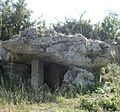Dolmen facts for kids
A dolmen is a very old type of stone structure, like a single room or chamber, built using huge stones. Imagine three or more tall, upright stones holding up a giant flat stone on top, like a table. These amazing structures are part of what we call megaliths, which means "big stones."
Most dolmens were built a very long time ago, during the early Neolithic period. This was the New Stone Age, roughly between 4000 BC and 3000 BC. That's about 6,000 to 7,000 years ago!
Originally, most dolmens were covered with earth or smaller stones. This created a large mound, often called a barrow or tumulus. Over thousands of years, the earth and smaller stones have often washed away. This leaves only the strong stone "skeleton" of the burial mound standing today.
Mysteries of the Past
It's still a bit of a mystery who built the first dolmens, why they did it, and exactly when. The oldest known dolmens are found in Western Europe. They were put in place around 7,000 years ago.
Archaeologists, who study ancient times, still don't know for sure who built these dolmens. This makes it hard to understand their exact purpose.
Were They Tombs?
Most experts believe dolmens were used as tombs or burial chambers. This means they were places where people buried the dead. However, there isn't always clear proof for this idea.
Sometimes, human remains or old tools have been found inside or near dolmens. Scientists can use radiocarbon dating to figure out how old these remains are. But it's hard to prove that these remains are from the same time the huge stones were first put there. It's possible people used the dolmens for burials much later.
Images for kids
-
Dolmens in Amadalavalasa, Andhra Pradesh, India
-
Dolmen at Ganghwa Island, South Korea
-
Trethevy Quoit - one of the best-preserved in Cornwall, UK dated to around 3500–2500 BCE
-
Chûn Quoit in Cornwall, UK, about 2400 BCE
-
Zennor Quoit in Cornwall, UK, 2500–1500 BCE
-
Lanyon Quoit in Cornwall, UK, 3500-2500 BCE
-
A dolmen erected by Neolithic people in Marayur, Kerala, India.
-
A southern-style dolmen at Ganghwa Island, South Korea
-
The biggest dolmen near Hwasun, South Korea
-
Kilclooney More dolmen near Ardara, County Donegal, Ireland
-
T-shaped Hunebed D27 in Borger-Odoorn, Netherlands
-
Dolmen of Bisceglie, Apulia
-
Tinkinswood, Vale of Glamorgan, Wales, around 3000 BCE
-
Dolmen of Oleiros, Galicia
-
Musealised Dolmen de Dombate, Galicia (Spain)
See also
 In Spanish: Dolmen para niños
In Spanish: Dolmen para niños





























